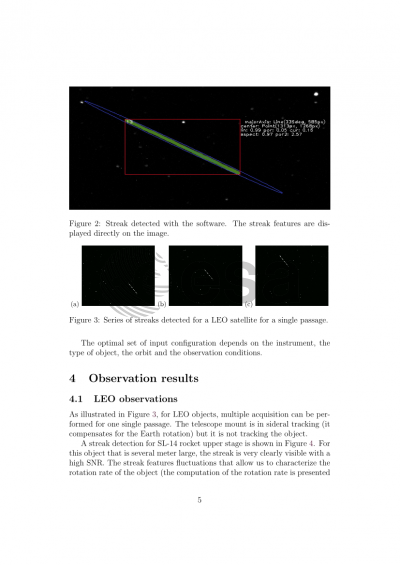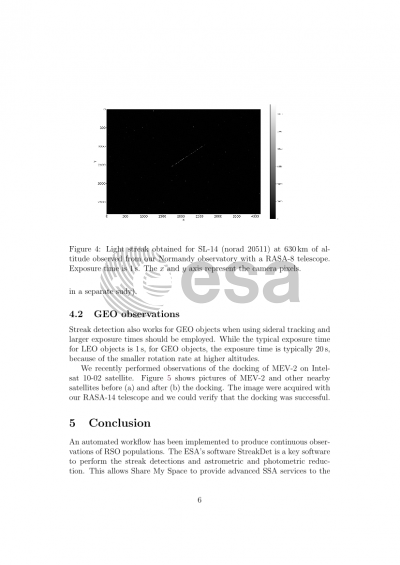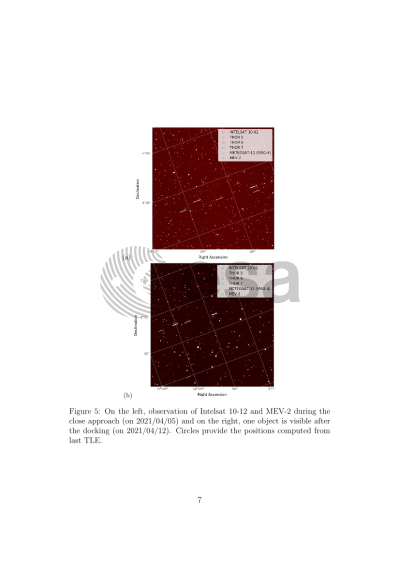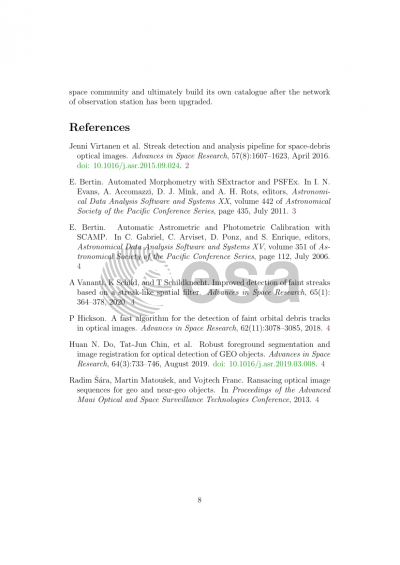Document details

Abstract
The identification and characterization of space debris is becoming essential today: over the next few years, more and more satellites will be launched, increasing the population of objects in Earth's orbit and the risk of collision. Whether GEO (Geostationary Earth orbit), MEO (Medium Earth orbit), or LEO (Low-Earth orbit), it is mandatory to develop tools for the observation and analysis of these orbiting objects. A recurring problem is the difficulty to detect objects with very small Signal-to-Noise Ratios (SNR).
To investigate this challenge we decided to build a small observatory with an 8-inch Rowe-Ackermann Astrograph Schmidt telescope (RASA). The RASA-8 has an effective focal length of 400 mm and an aperture of 203 mm. This telescope allows us to perform GEO and LEO observations. The streaks we get are either bright, faint, long, or short. They have a magnitude close to 8 for LEO satellites, which is well detected by our telescope.
In order to detect faint streaks, we use the StreakDet (Streak detection and astrometric reduction) software provided by ESA. StreakDet is designed to detect objects trails using astrometric and photometric processes. It is divided into three main phases: segmentation, classification, astrometric and photometric reduction as described in [Virtanen et al., 2016]. The segmentation consists of a robust low-SNR extraction of all necessary information (features) from one image. The classification is the characterization and efficient reduction of the extracted data. The astrometric and photometric reduction package provides tools for coordinate and magnitude measurements.
Considering the setup currently at work, we want to extract most of the datasets obtained. To that end, we test Streakdet and other software in order to find its limits, and decide if it allows us to get acceptable results with GEO and LEO satellites detection.
First, we compare the segmentation of StreakDet with SExtractor (Source-Extractor) [Source-Extractor Bertin and Arnouts, 1996]. SExtractor is a software that creates a catalog of objects from images observed by our telescope. Then, the astrometric and photometric reduction phase of StreakDet is tested in comparison to the SCAMP software [Bertin, 2006]. SCAMP uses SExtractor catalogs in order to perform its astrometric and photometric reduction. Tests are carried out with all our data: high and low SNR, long, short, faint, and bright streaks.
Overall, we are seeking the best tools to analyze the data and detect streaks with our observations. We will present the results of our comparison of the tools presented here.
References :
E. Bertin.Automatic Astrometric and Photometric Calibration with SCAMP. In C. Gabriel, C. Arviset, D. Ponz, and S. Enrique, editors, Astronomical Data Analysis Software and Systems XV, volume 351 of Astronomical Society of the Pacific Conference Series, page 112, July 2006
E. Bertin and S. Arnouts. SExtractor: Software for source extraction.A&Asupp., 117:393–404, June 1996. DOI: 10.1051/aas:1996164.
Jenni Virtanen et al. Streak detection and analysis pipeline for space-debris optical images. Advances in Space Research, 57(8):1607–1623, April 2016. DOI: 10.1016/j.asr.2015.09.024.
Preview









